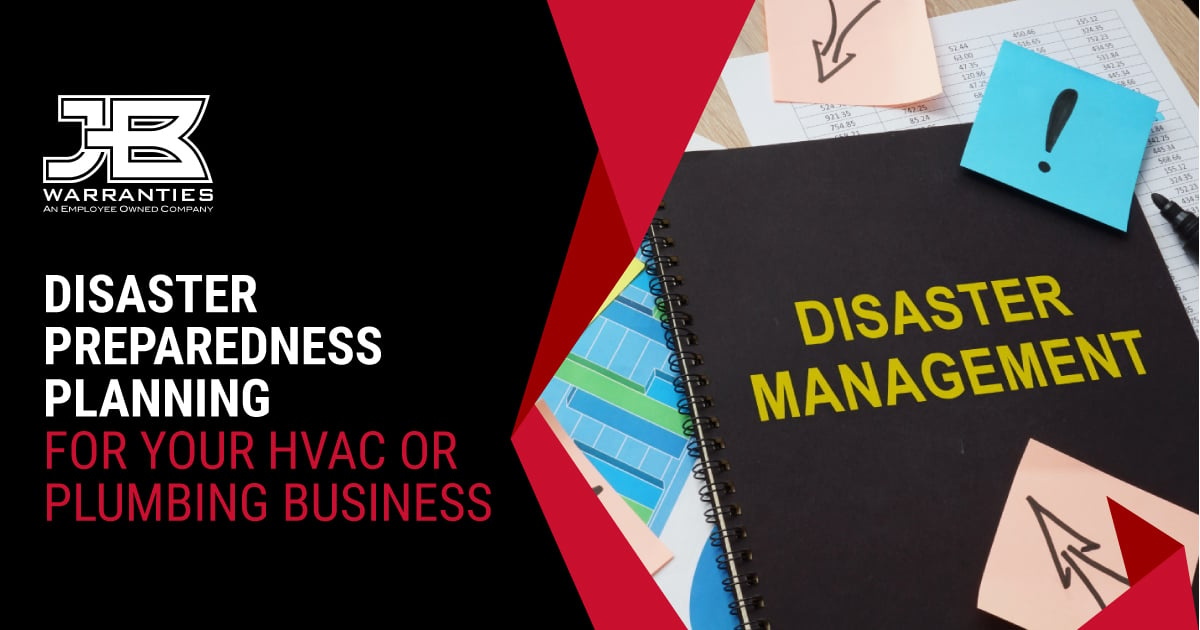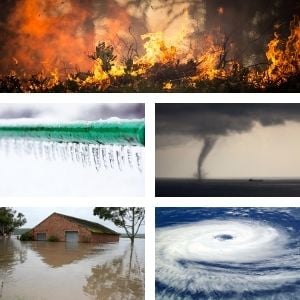
September 1st marks the start of National Preparedness Month (NPM), a time for families and businesses alike to become involved in disaster planning. In 2020, we’ve seen plenty of disasters: pandemic, fires, earthquakes, hurricanes, flooding, a derecho storm, and more have wreaked havoc on many communities. If nothing else, 2020 has taught us that there’s no better time than now to create a plan to protect your business and employees.
The theme of the 2020 NPM is, “Disasters don’t wait, make your plan today.” So, to kick off this first week of September, here’s a checklist of how to create a disaster plan for your HVAC or plumbing business.
Let’s get started!
Step 1: Create a Checklist of Assessment Questions
The first critical step to developing a preparedness plan is to construct a checklist of assessment questions. These questions should be geared towards all supporting angles of your HVAC or plumbing business, including your employees, customers, and assets. Understanding these immediate needs helps you gain a better outlook on how to tackle any unexpected events your company may face.
-
 What are the largest threats to your business?
What are the largest threats to your business?
- Hurricanes
- Winter Weather
- Tornadoes
- Floods
- Wildfires
Various disaster types can pose a higher risk to your business, depending on your locality. Do you live in a dry climate that’s at a higher risk of wildfires? Is your tropical climate prone to hurricanes? It’s vital to acknowledge which disaster types pose the most massive threat to your business’ location and prepare accordingly.
- How will you communicate with your employees and clients in the event of a disaster?
- Designate phone, email, addresses, social media contacts
- Incorporate multiple forms of communication if some channels are disrupted, such as landlines, social media platforms, or physical meeting locations when possible
Establishing an effective emergency communication plan will allow your team to remain productive if regular communication hubs are affected.
- Will you have access to trucks, equipment, and supplies?
- Develop a list of distributors to allow for multiple resource options in the event of a disaster
- Consider maintaining various storage facilities for vehicles and equipment to provide multiple access points
- How will you access customer records?
- Routinely back up and store data remotely, either using an online cloud system or drive
- In the event of losing power, maintain an emergency generator-powered computer source to hold all of your customer records
Whether a physical or cloud-based copy, the ability to access necessary records will go a long way when sending technicians into the field after a disaster. A secure back-up ensures technicians can locate details such as a customer’s location, phone number, and applicable warranty information to safely and quickly tackle concerns in the event of an emergency.
- How does your team manage work requests in the event of a disaster?
- Designate emergency contacts
- Educate and understand local alternative routes in the case of road closures
- Create protocol on how to prioritize service requests and properly issue expected response times
In the event of a disaster, business operations’ usual flow can be completely thrown off track. When work orders need to be completed, consider establishing an emergency protocol employees can follow to remain on schedule.
Step 2: Consider Specific Areas of Protection
 When drafting your disaster preparedness plan, bear in mind specific areas of your business will require protective action. In most HVAC and plumbing companies, employee, customer, and asset protection protocols should be established to safeguard your bottom line. Consider these three common points when contemplating which specific areas of your business require protection.
When drafting your disaster preparedness plan, bear in mind specific areas of your business will require protective action. In most HVAC and plumbing companies, employee, customer, and asset protection protocols should be established to safeguard your bottom line. Consider these three common points when contemplating which specific areas of your business require protection.
1. Asset Protection
From vehicle fleets to heavy, expensive equipment, HVAC and plumbing businesses hold numerous assets that demand protective action. In the face of a disaster, secure your resources in multiple locations that offer strong security and protection from the elements, such as local storage facilities. Likewise, you must keep your physical office location stocked for emergency events. Fire alarms and extinguishers, back-up generators, and basic first-aid kits should always remain on-site in the event of a disaster. Remember to maintain and review your insurance coverage annually in case your assets suffer heavy damage unexpectedly.
2. Employee Protection
Aside from your company’s assets, your employees will require protective action as well. If technicians are expected to respond to customer calls in the event of an emergency, it's an absolute must they remain prepared with all necessary supplies and protective equipment. Hard hats, protective clothing, and first-aid kits are just some of the supplies you should consider gearing your employees with. If your company offers health insurance for employees, make sure to maintain good standing with the provider, and provide employees with all the necessary information. Your technicians should also be provided with all of the important emergency contacts, including local police, fire, and gas.
3. Customer Protection
When disasters strike, customers can be quick, not to mention frantic, to book your services. To protect both your employees and customers, be sure to prioritize orders in a manner that tackles the most significant issues first.
As part of your disaster preparedness plan, consider implementing a service-by-phone process for addressing minor inconveniences. This process can help keep techs safe by keeping them off the road while driving conditions may still be dicey. Plus, this option helps your team prioritize the most critical cases. Customers facing possible home-destroying work orders can have their needs addressed immediately, and smaller issues can be tackled remotely.
Likewise, take the time to educate customers on emergency system practices in advance to prevent frantic phone calls down the line. Remind existing warranty holders of their coverages in the case of failure and inform current customers of your emergency protocol.
Share Generator Safety Tips with Your Customers
Do you live in an area prone to severe weather conditions such as hurricanes or blizzards? If that’s the case, then chances are that many folks in your community have portable generators to help them get through any disruptions to electric service.
Unfortunately, many people don’t know the necessary safety precautions for using a portable generator leading to injury and even death.
Share these tips with your customers to help them safely operator their generators:
- Only operate your generator outdoors where there is adequate ventilation. Never run it in the house or garage.
- Never plug the generator directly into the wall to avoid feedback. Use a heavy-duty extension cord.
- Get the generator running before you plug appliances into it, and don’t overload it with too many things on at once.
- Avoid running generators in the rain or wet conditions to limit the risk of electrocution.
- Let your generator cool down before refueling it.
- Help your children and pets avoid getting burned by keeping them away from the generator.
Another way you can help your customers prepare for the next storm season is to offer them an extended warranty on portable generator.
Sign up for the  with JB Warranties to offer these extended warranties and more to your customers.
with JB Warranties to offer these extended warranties and more to your customers.
Step 3: Implement Processes and Train Staff
Once you’ve created an assessment checklist and acknowledged which areas require protection, you must implement these processes and adequately train your staff immediately. Consider holding routine training seminars to educate technicians on the appropriate practices when working in the event of a disaster. Implement evacuation and alternative routes, inform of any first-aid practices, and share personal protective measures to protect your employees’ safety and well-being on the job.
Be sure to distribute all necessary emergency communication, including:
- Emergency contacts
- Alternative forms of communication
- Employee to customer communication
- Protocols for coordinating with law enforcement, fire officials, utility companies, and other emergency responders
Make Your Plan Today
While no business is 100 percent safe from the unexpected, it is possible to prepare for the worst. From assessing your business to understanding where you are most vulnerable, you gain the ability to prepare your employees and customers and protect your assets from a disaster.

Tommy Cue
Vice President of Strategic Partnerships at JB Warranties






